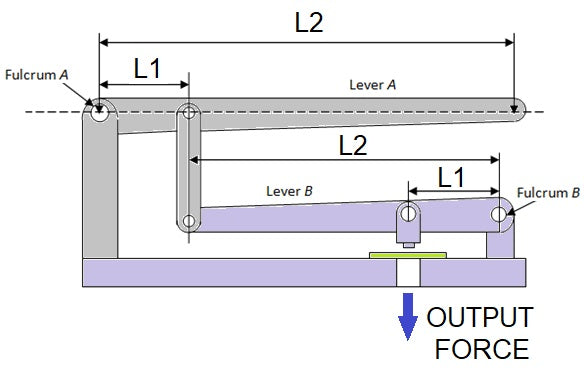How does the Compound Lever work

A compound lever is a system that consists of two or more simple levers working together to transmit force and motion. In a compound lever, the output force or motion from one lever becomes the input force or motion for the next lever. This arrangement allows the compound lever to achieve a greater mechanical advantage or amplify the force applied, making it easier to move heavy loads or perform tasks that require significant force.
Here's a step-by-step explanation of how a compound lever works:
- The user applies an effort (input force) on the first lever in the system.
- The first lever amplifies the input force based on its mechanical advantage, which is determined by the ratio of the lengths of its effort arm and load arm.
- The amplified force from the first lever is then applied as the input force to the second lever.
- The second lever further amplifies the force based on its mechanical advantage.
- If there are additional levers in the system, the force is transmitted and amplified through each one, following the same process.
- The final lever in the system applies the output force (or load) to the desired point, making it easier to move or manipulate the load.
Compound levers are often used in applications where a large mechanical advantage is required, such as in heavy machinery, hand tools, and lifting systems. By combining multiple simple levers, a compound lever can achieve a greater mechanical advantage than a single lever, making it more efficient at performing tasks that require significant force.
What is the calculation for a Compound Lever?
To determine the output force, you need to calculate the total mechanical advantage (MA) of the compound lever system and then multiply it by the input force (effort). The total mechanical advantage is obtained by multiplying the mechanical advantages of each individual lever in the system.
Diagram of a compound lever

Here's the general formula for calculating mechanical advantage (MA) of a single lever:
MA = Distance from Effort to Fulcrum (DE) / Distance from Load to Fulcrum (DL)
For a compound lever system with two levers, you would calculate the mechanical advantage of each lever and then multiply the two values:
Total MA = MA of Lever 1 × MA of Lever 2
If the compound lever system has more than two levers, you can extend this method by multiplying the mechanical advantages of all individual levers:
Total MA = MA of Lever 1 × MA of Lever 2 × ... × MA of Lever n
Finally, to calculate the output force (F_out) of the compound lever system, multiply the total mechanical advantage by the input force (F_in):
F_out = Total MA × F_in
Please note that this calculation assumes no energy losses due to friction or other inefficiencies in the system. In real-world applications, you may need to account for such factors to obtain accurate results.
Compound Lever Calculator
Lever 1
Lever 2
Input Force
Results
Example of a Compound Lever

A Press is a type of compound lever mechanism. They are used in most fabricaion and mecahine factories. This type of mechanisms is used because the input force is usually applied by a human with limited force capabilities, however, the force required to punch a hole through a sheet of steel is many magnitudes more than this, and so a compound lever is required to Amplify the human input force to create a 10x more output force, or enough to punch a steel plate.